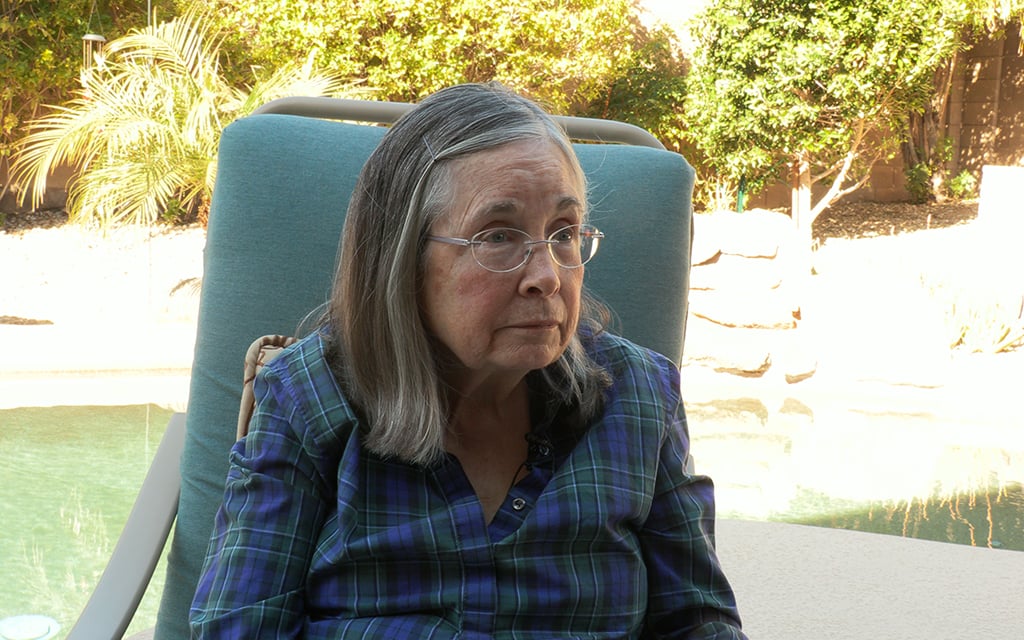
Adult Loss of Hearing Association’s (from left) executive board member Sue Vardon, donor match partner Pat Clinch and Board President Cynthia Amerman pose for a portrait at the Adult Loss of Hearing Association in Tucson on May 11, 2023. (Photo courtesy of Cynthia Amerman)
PHOENIX – Cochlear implants have been available in the U.S. since 1961. However, the deaf community is divided over whether getting a cochlear implant undermines deaf identity and culture.
A cochlear implant is a small electronic hearing device, with one part surgically implanted into the bone surrounding the ear and one part placed on the ear like a hearing aid. It allows people who are deaf or very hard of hearing to receive and process sounds and speech; it does not, however, restore normal hearing.
The devices have gone through many iterations since they were first introduced in the 1960s, with the Food and Drug Administration issuing approval for one model as recently as 2022.
Cynthia Amerman, board president of the nonprofit Adult Loss of Hearing Association (ALOHA), has been working with people with hearing loss her whole adult life and has cochlear implants herself. She also has a master’s degree in social work from Gallaudet University, the country’s first college for the education and professional development of deaf and hard-of-hearing individuals.
Amerman had progressive hearing loss that started as a young child. Her earliest memory of it was in second grade when she couldn’t hear her teacher.
“I used to get in trouble for not understanding the directions and for not doing what she thought I should do. I tried to be good, but it was hard when I didn’t understand,” Amerman said.
At age 42, in 1984, Amerman had a sudden, complete hearing loss in her left ear. Within the next 15 years, she became almost entirely deaf in both ears, Amerman said.
Amerman tried to get cochlear implants many times, but had to wait a long time because the only test she could take to qualify involved signaling when she heard a beep in her ear.
“It was very hard because if you have tinnitus in your ear, if you have ear ringing, it’s very easy to confuse the ringing in your ear … with the beeps,” Amerman said.
According to an article in the journal Nature, speech perception tests are better at determining a person’s candidacy for a cochlear implant and have become the standard for assessing a person’s hearing.
In 2006, Amerman was able to take a speech recognition test that made her eligible, with a score of 60% or less. She got a cochlear implant in her left ear, and in 2013, she got a second implant in her right ear.
According to Michael Dorman, an emeritus professor of speech and hearing sciences in the College of Health Solutions at Arizona State University, and a consultant for a cochlear implant manufacturer, the 60% or less threshold for speech recognition was chosen because data showed that an implant would improve the hearing of someone below that level.
Daniel Bos, an audiologist and assistant teaching professor in the speech and hearing sciences at ASU’s College of Health Solutions, said that an implant will not bring someone’s speech recognition back to 100%. “Sometimes that improvement is a jump from 30% understanding to 50% understanding, but if you think about any given day, that’s a significant jump,” he said.
Amerman’s first experience with the deaf community was in her sign language class, which required her to go to deaf events in the area. Since then, she has gained a lot of experience with the community in previous jobs and in her current job in ALOHA.
Some deaf people think cochlear implants are a way to turn your back on deaf identity, Amerman said. “They are threatened by the fact that their language (American Sign Language) might go extinct if people only use cochlear implants from now on.”
The medical model regards people who are deaf or hard of hearing as deficient and that deafness is something that needs to be fixed. This model led to bias against people who are deaf or hard of hearing and a hearing culture that uses phrases like “deaf and dumb,” and “deaf-mute,” to describe those who have hearing loss.
“That’s what the medical model says (deafness is), something that needs to be fixed, but I do not believe that myself,” Amerman said.
Amerman is grateful that she was able to get cochlear implants.
The two ASU professors of speech and hearing sciences had different views on how cochlear implants affect deaf culture.
“Parents want their children to do better than they did. To have more than they did,” Dorman said. “Personally, I find it very odd that one would want their child not to hear and not to have the greatest range of possibilities.”
Bos had a different viewpoint.
“Their views, and rightly so, are, ‘There is nothing wrong with us. We have our own community, our own culture. We have our own language.’ There’s nothing to fix and they’re right in thinking that,” Bos said. “Our job as audiologists is never to put into someone’s head that we’re there to fix them. Our job is to help people hear.”


